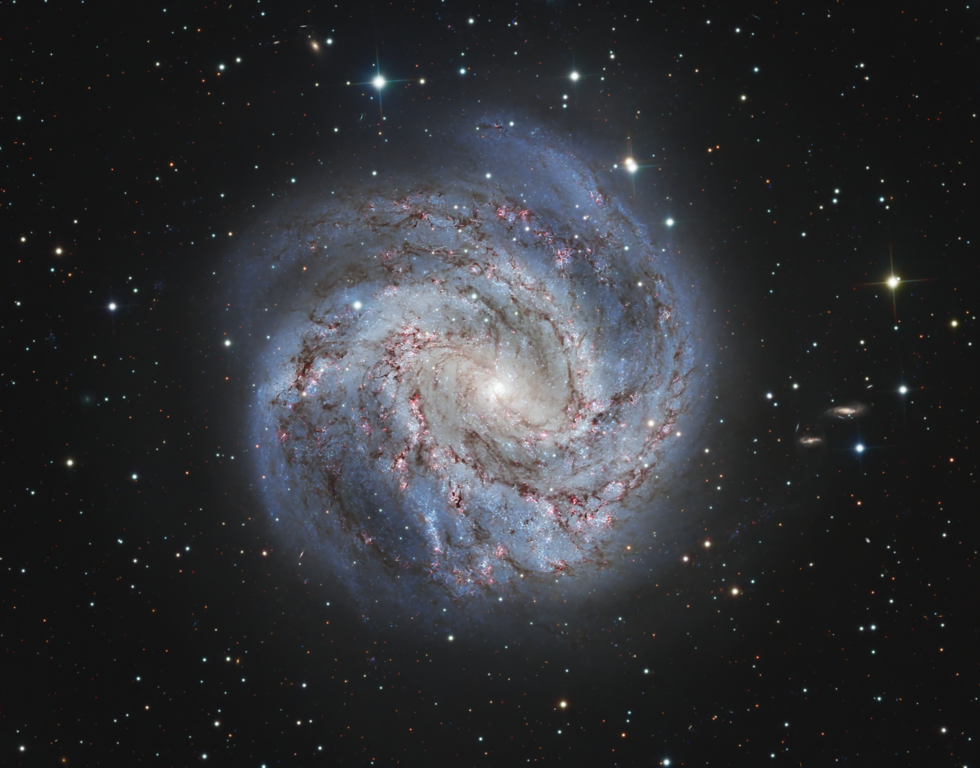M83 - The Southern PinWheel Galaxy in LRGB
M83 - The Southern PinWheel Galaxy in LRGB
Messier 83 or M83, also known as the Southern Pinwheel Galaxy and NGC 5236, is a barred spiral galaxy approximately 15 million light-years away in the constellation borders of Hydra and Centaurus. Nicolas-Louis de Lacaille discovered M83 on 17 February 1752 at the Cape of Good Hope. Charles Messier added it to his catalogue of nebulous objects (now known as the Messier Catalogue) in March 1781.
It is one of the closest and brightest barred spiral galaxies in the sky and is visible with binoculars. It has an isophotal diameter at about 36.24 kiloparsecs (118,000 light-years). Its nickname of the Southern[a] Pinwheel derives from its resemblance to the Pinwheel Galaxy (M101).
Characteristics
M83 is a massive, grand design spiral galaxy. Its morphological classification in the De Vaucouleurs system is SAB(s)c, where the 'SAB' denotes a weak-barred spiral, '(s)' indicates a pure spiral structure with no ring, and 'c' means the spiral arms are loosely wound. The peculiar dwarf galaxy NGC 5253 lies near M83, and the two likely interacted within the last billion years resulting in starburst activity in their central regions.
The star formation rate in M83 is higher along the leading edge of the spiral arms, as predicted by density wave theory. NASA's Galaxy Evolution Explorer project on 16 April 2008 reported finding large numbers of new stars in the outer reaches of the galaxy—20 kpc from the center. It had hitherto been thought that these areas lacked the materials necessary for star formation.
Supernovae
Six supernovae have been observed in M83: SN 1923A (mag. 14), SN 1945B (mag. 14.2), SN 1950B (mag. 14.5), SN 1957D (mag. 15), SN 1968L (mag. 11.9), and SN 1983N (type Ia, mag. 11.9).
Environment
M83 is at the center of one of two subgroups within the Centaurus A/M83 Group, a nearby galaxy group. Centaurus A is at the center of the other subgroup. These are sometimes identified as one group, and sometimes as two. However, the galaxies around Centaurus A and the galaxies around M83 are physically close to each other, and both subgroups appear not to be moving relative to each other.
It is one of the closest and brightest barred spiral galaxies in the sky and is visible with binoculars. It has an isophotal diameter at about 36.24 kiloparsecs (118,000 light-years). Its nickname of the Southern[a] Pinwheel derives from its resemblance to the Pinwheel Galaxy (M101).
Characteristics
M83 is a massive, grand design spiral galaxy. Its morphological classification in the De Vaucouleurs system is SAB(s)c, where the 'SAB' denotes a weak-barred spiral, '(s)' indicates a pure spiral structure with no ring, and 'c' means the spiral arms are loosely wound. The peculiar dwarf galaxy NGC 5253 lies near M83, and the two likely interacted within the last billion years resulting in starburst activity in their central regions.
The star formation rate in M83 is higher along the leading edge of the spiral arms, as predicted by density wave theory. NASA's Galaxy Evolution Explorer project on 16 April 2008 reported finding large numbers of new stars in the outer reaches of the galaxy—20 kpc from the center. It had hitherto been thought that these areas lacked the materials necessary for star formation.
Supernovae
Six supernovae have been observed in M83: SN 1923A (mag. 14), SN 1945B (mag. 14.2), SN 1950B (mag. 14.5), SN 1957D (mag. 15), SN 1968L (mag. 11.9), and SN 1983N (type Ia, mag. 11.9).
Environment
M83 is at the center of one of two subgroups within the Centaurus A/M83 Group, a nearby galaxy group. Centaurus A is at the center of the other subgroup. These are sometimes identified as one group, and sometimes as two. However, the galaxies around Centaurus A and the galaxies around M83 are physically close to each other, and both subgroups appear not to be moving relative to each other.
SPECIFICATIONS
Telescope
Planewave CDK-24 (CHIk-1)
Camera
QHY600M
Location
El Sauce, Chile
Date of observation
April 2023- 2024
Filters
Astrodon L, R, G, B
Processing
PixInsight
Comments
Nice work George!



